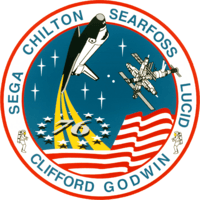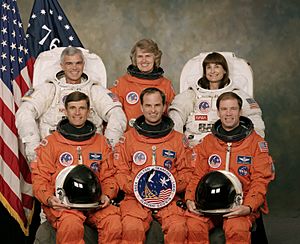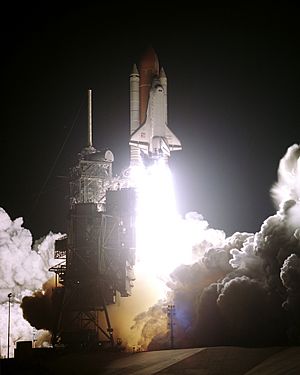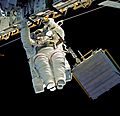STS-76 facts for kids

Atlantis connects with Mir's Docking Module
|
|
| Names | Space Transportation System-76 |
|---|---|
| Mission type | Shuttle-Mir |
| Operator | NASA |
| Mission duration | 9 days, 5 hours, 16 minutes, 48 seconds (achieved) |
| Distance travelled | 6,100,000 km (3,800,000 mi) |
| Orbits completed | 145 |
| Spacecraft properties | |
| Spacecraft | OV-104 |
| Launch mass | 111,740 kg (246,340 lb) |
| Landing mass | 95,396 kg (210,312 lb) |
| Payload mass | 6,753 kg (14,888 lb) |
| Crew | |
| Crew size | 6 up 5 down |
| Members |
|
| Launching | |
| Start of mission | |
| Launch date | 22 March 1996, 08:13:04 UTC |
| Rocket | Space Shuttle Atlantis (mission 16) |
| Launch site | Kennedy Space Center, LC-39B |
| Contractor | Rockwell International |
| End of mission | |
| Landing date | 31 March 1996, 13:28:57 UTC |
| Landing site | Edwards Air Force Base, Runway 22 |
| Orbital parameters | |
| Reference system | Geocentric orbit |
| Regime | Low Earth orbit |
| Perigee | 389 km (242 mi) |
| Apogee | 411 km (255 mi) |
| Inclination | 51.60° |
| Period | 92.50 minutes |
| Docking with Mir | |
| Docking port | SO starboard |
| Docking date | 24 March 1996, 02:34:05 UTC |
| Undocking date | 29 March 1996, 01:08:03 UTC |
| Time docked | 4 days, 22 hours, 33 minutes, 58 seconds |
 STS-76 mission patch  Back: Clifford, Lucid, Godwin Front: Sega, Chilton, Searfoss |
|
STS-76 was a special space mission by NASA's Space Shuttle ''Atlantis''. It was the 76th Space Shuttle flight and the 16th for Atlantis. The mission began on March 22, 1996, launching from Kennedy Space Center.
This exciting journey lasted over nine days. Atlantis traveled about 6.1 million kilometers (3.8 million miles). It orbited Earth 145 times before landing on March 31, 1996, at Edwards Air Force Base.
The main goal of STS-76 was to connect with the Russian Mir space station. This was part of the Shuttle-Mir program, where U.S. Space Shuttles visited the Russian station. The mission also carried astronaut Shannon Lucid to Mir. She would live there for several months.
Another important part of the mission was a spacewalk. Astronauts Linda M. Godwin and Michael R. Clifford performed this spacewalk. It was the first time U.S. astronauts walked in space around two connected spacecraft since 1974.
Meet the Astronauts
The STS-76 mission had a crew of six skilled astronauts. They worked together to make the mission a success.
- Commander: Kevin P. Chilton
- Pilot: Richard A. Searfoss
- Mission Specialist 1: Ronald M. Sega
- Mission Specialist 2: Michael R. Clifford
- Mission Specialist 3: Linda M. Godwin
- Mission Specialist 4: Shannon Lucid (She stayed on the Mir space station)
Spacewalk Details
A spacewalk, also known as an EVA, is when an astronaut leaves their spacecraft to work in space. On this mission, two astronauts performed a spacewalk.
- Astronauts: Linda M. Godwin and Michael R. Clifford
- Start Time: March 27, 1996 – 06:34 UTC
- End Time: March 27, 1996 – 12:36 UTC
- How Long: 6 hours and 2 minutes
Mission Highlights
This mission was the third time a U.S. Space Shuttle linked up with the Russian Mir space station. A major part of the mission was bringing astronaut Shannon Lucid to Mir. She became the first American woman to live on the station.
Shannon Lucid stayed on Mir for about four and a half months. Her stay broke the record for the longest time an American had lived in space. She was later replaced by astronaut John Blaha during the STS-79 mission. Her time on Mir started a period where Americans were continuously in space for two years.
Atlantis carried a special module called SPACEHAB. This module was in the shuttle's cargo bay. It was the first time a SPACEHAB module was used to support Shuttle-Mir dockings. The module was mainly used to store lots of equipment. This equipment was then moved to the Mir space station.
The SPACEHAB also held the European Space Agency's Biorack experiment rack. This rack was used for science experiments in space.
Atlantis connected with Mir on the third day of the flight. The connection happened at 21:34 EST on March 24, 1996. After connecting, the hatches between the two spacecraft were opened. Mir 21 Commander Yury Onufriyenko and Flight Engineer Yuri Usachov were waiting on Mir.
During the five days Atlantis was docked, about 680 kilograms (1,500 pounds) of water were transferred to Mir. Also, two tons of scientific gear and supplies were moved over. In return, experiment samples and other equipment were brought back to Atlantis.
The Biorack experiments studied how space affects living things. Scientists looked at plants, tissues, cells, bacteria, and insects. They also studied how being in space affects bone loss. Other items transferred included equipment for a glovebox already on Mir.
On flight day six, astronauts Godwin and Clifford performed their spacewalk. They attached four Mir Environmental Effects Payload (MEEP) experiments to Mir's docking module. These experiments would study the space environment around Mir for 18 months. Godwin and Clifford wore special devices called Simplified Aid For EVA Rescue (SAFER). These devices help astronauts move around safely during a spacewalk.
Other experiments on board included the Shuttle Amateur Radio Experiment (SAREX). There was also KidSat, a project that lets middle school students take part in space exploration. Another experiment was Trapped Ions in Space (TRIS). This was a science experiment carried in a special container in the shuttle's cargo bay.
Gallery
-
Astronaut Linda M. Godwin during EVA 1.





